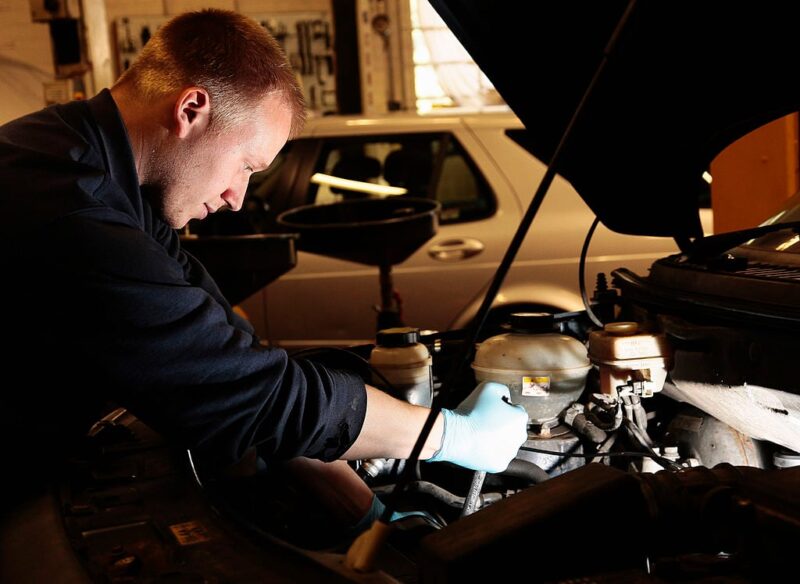Older cars stay reliable only when they receive consistent, targeted upkeep. The real answer for keeping any aging vehicle running smoothly is a mix of preventive maintenance, faster reaction to early warning signs, and regular deep cleaning that protects the exterior and interior from accelerated wear.
When these habits become routine, cars well over 10 or 15 years old can remain dependable daily drivers without sudden costly failures.
Older engines, suspensions, electrical systems, and cooling parts do not fail without warning. They show small signs long before something major happens. That is why drivers who notice small changes in sound, vibration, or temperature keep their cars out of the repair shop more often.
A proactive approach always costs less than ignoring symptoms until something breaks. The sections below explain the habits that matter most and why they extend the life of a high-mileage car.
1. Oil Changes Based on Condition, Not Just Time
Older engines burn oil faster, collect sludge more easily, and rely heavily on clean lubrication. While modern cars can sometimes stretch oil intervals, older vehicles cannot. They need oil changes every 5,000 to 7,000 kilometers, sometimes sooner if the engine burns oil or the car is driven mostly in stop-and-go city traffic.
Checking the dipstick every two weeks prevents low-oil operation, which is one of the fastest ways to destroy an older engine. Fresh oil improves cooling, protects worn metal surfaces, and reduces fuel consumption.
2. Cooling System Health Comes First
Overheating is one of the most common causes of sudden engine failure in cars over 12 years old. Radiators clog, water pumps weaken, and old rubber hoses crack from the inside. The simple habit that saves an older engine is flushing the coolant every two years and inspecting the hoses and clamps twice a year.
A weak thermostat or radiator cap can also lead to silent overheating that happens during long highway drives. Replacing these cheap parts early avoids warped cylinder heads and blown gaskets.

3. Suspension and Steering Checks Avoid Dangerous Wear
Older suspensions fail slowly. Bushings dry out, shocks lose pressure, and ball joints loosen. These problems affect stability long before drivers notice anything obvious.
Checking the suspension once a year keeps the car safe and prevents uneven tire wear. Steering systems in older vehicles also develop play, especially if tie-rod ends or rack boots start to leak. Addressing these issues early keeps the car predictable, firm, and quiet on the road.
4. Brake System Refresh Before Problems Appear
Brakes on older cars rust faster, accumulate moisture in the brake fluid, and wear irregularly. The habit that extends system life is replacing brake fluid every two years and inspecting pads, calipers, and lines every time the wheels come off.
Moisture in the fluid reduces braking power and corrodes internal parts. A simple flush often restores performance and prevents expensive repairs. Rear drums, if the car has them, should be cleaned and adjusted periodically to maintain balance and reduce strain on the front brakes.
5. Electrical System Maintenance Saves You From Surprises
Aging wiring, corroded grounds, weak alternators, and tired batteries cause random failures in older cars. Electrical issues start small: dim lights, slow window motors, or inconsistent starting.
Cleaning battery terminals, checking grounds, and measuring alternator output once a year prevents most of these problems. Replacing an aging battery before it dies also protects the alternator from overworking.
6. Transmission and Gearbox Care Extends Drivetrain Life
Automatic transmissions need fluid changes more often as they age. Old fluid loses its ability to cool and maintain pressure. Changing transmission fluid and filter every 50,000 to 70,000 kilometers keeps the gearbox healthy.
Manual transmissions benefit from fresh gear oil as well, especially if the car has noisy shifts or stiff engagement. Ignoring this is one of the reasons older cars suddenly develop expensive drivetrain issues.

7. Protecting the Body and Interior From Accelerated Aging
Mechanical parts are only half the equation. Rust, paint wear, and interior deterioration accelerate on older cars. A deep cleaning session at least twice a year preserves value and prevents hidden damage.
Midway through the maintenance cycle, many owners schedule deep cleaning from services like full valet Manchester to restore exterior shine, rejuvenate worn materials, remove corrosive contaminants, and extend the life of seals and surfaces. A clean and protected car always ages more slowly than one exposed to dirt, salt, and moisture.
8. Tires and Alignment Must Stay in Top Shape
Older cars benefit more from high-quality tires than new ones do. As suspension components age, good tires compensate for some of the lost stability.
Checking tire pressure weekly ensures steady fuel economy and protects the sidewalls from premature damage. Alignment should be done once a year to prevent uneven wear, drifting, and steering issues.
9. Listening to the Car Makes the Biggest Difference
The middle answer to keeping an older car running smoothly is simple: respond quickly to any new sound, smell, or vibration. High-mileage engines rarely fail suddenly. They fail because early symptoms are ignored.
A ticking noise may be a loose lifter. A burning smell may be a leaking valve cover. A new vibration at highway speeds may indicate a wheel bearing starting to fail. Addressing these small signs early saves thousands in repairs.

10. Keep Records and Build a Maintenance Routine
Older cars last much longer when owners track what has been replaced and what needs attention next. A logbook prevents repeated issues and helps mechanics diagnose problems faster. It also reveals patterns, like how quickly oil drops or when belts typically need replacement.
Conclusion
Older cars run smoothly only when owners stay ahead of predictable wear. Regular oil and fluid refreshes, cooling system care, brake inspections, clean electrical contacts, proper tire maintenance, and periodic deep cleaning form the core habits that keep aging vehicles reliable.
When these practices become routine, older cars stay on the road longer, cost less to own, and remain comfortable and safe for everyday use.
Related Posts:
- The Importance of Electrical System Maintenance:…
- How to Keep Your Dog Happy and Healthy - Essential Care Tips
- Hairstyles for Older Men with Thinning Hair
- These 7 Sleeping Habits are Damaging Your Look - 2024 Guide
- 5 Healthy Habits That Wont Break Your Budget
- From Diet to Lifestyle: 7 Long-Term Habits for…









